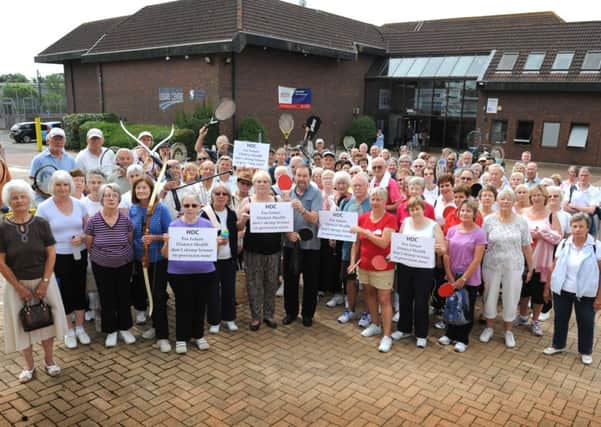DEBATE: Should council adopt ‘People’s Vision’ on new Broadbridge Heath Leisure Centre?


Almost two years ago members of Broadbridge Heath Leisure Centre (BBHLC) forced the council to commit to ‘Option 7A: the People’s Option’, which contained the minimum level of services users were willing to accept in a new facility.
The victory represented a policy u-turn as Horsham District Council had originally announced the demolition of the centre with no replacement in November 2011.
Advertisement
Hide AdAdvertisement
Hide AdIn February HDC unveiled its masterplan for the Broadbridge Heath Quadrant including the provision of a new leisure centre, consultation on which closed several weeks ago.
But in response to proposals, which users feel only pay ‘lip service’ to leisure, BBHLC’s Joint User Group (JUG) along with the Horsham District Indoor Bowls Club, has re-ignited its campaign by launching ‘The People’s Vision’ for a new facility, a list of 12 principles they are asking HDC to sign up to.
The group argues this will not only soundly steer the project to a successful conclusion, it will also improve existing users’ confidence that the new centre will be widely acceptable.
The 12 principles are:
Principle 1 – District Facility
As with the existing BBHLC, the new complex is to complement the Pavilions as a flagship district leisure centre with appropriate facility scale & facility mix.
Principle 2 – Capacity/Expansion
Advertisement
Hide AdAdvertisement
Hide AdThe new centre is to have the capacity to meet the demand from current residents and the extra demand arising from the strategic West of Horsham housing developments. In addition it should be designed to meet future demand from population growth during the life of the building, say 25 years, either by inbuilt capacity or by expandable design. HDC must publish the basis on which the design capacities are calculated.
Principle 3 – User Recognition
HDC must recognise all existing Users as key stakeholders. Some could be considered to have a ‘moral freehold’ due to the deal to relocate them here in 1985 to make way for the Tesco superstore development.
Priority should therefore be given to meeting the incumbents’ reasonable needs as part of HDC’s decision to redevelop the site.
Principle 4 – Community Engagement
HDC should look for every opportunity to engage the community (including users) in the project through joint working & evaluation; for example, key user representatives could be co-opted onto working groups & committees. Not only would this improve public confidence in decision making but their skills, knowledge & commitment would be an asset to the project. Any consultation should also give the community meaningful options with real choice & influence.
Principle 5 – Accessibility
Advertisement
Hide AdAdvertisement
Hide AdThe current facilities are highly accessible to all, incorporating a number of specific provisions for the disabled. The replacement facility must not degrade these; if anything they should be improved.
Principle 6 – Car Parking
Parking should remain free & be adequate. HDC should detail their calculations as to the number & type of spaces provided & clearly indicate which facilities are covered by which car park.
Principle 7 – Catering
The catering provision should incorporate a ‘good sized’ cafeteria, kitchen and bar with the ability to additionally cater for club meals & functions (meetings, parties, events etc.). The cafeteria is to provide ‘social meeting space’ as well as simply ‘eating space’.
Principle 8 – Redevelopment Opportunity
This ‘once in a generation’ redevelopment opportunity of district scale leisure provision should seek to address some of the long outstanding shortfalls identified in HDC’s leisure facility assessment. For example, this is an ideal opportunity to consider provision for Indoor Tennis, a known deficiency for 10 years & which was originally proposed to be satisfied by the planned leisure centre expansion in the adopted West of Horsham Masterplan.
Principle 9 – Continuity of Provision
Advertisement
Hide AdAdvertisement
Hide AdHDC should re-confirm their previously & clearly stated position that continuity of service provision will be provided. All existing facilities must be adequately maintained & remain fully open until replaced.
Principle 10 – BJUG Minimum Requirements
These should be formally accepted as a key project document with a commitment from HDC to explain & discuss, with supporting evidence, if what is proposed by HDC and/or its developers is deficient or different from BJUG’s minimum requirements. Note these are minimum ‘universal’ requirements, with clubs, organisations & even individuals free to press their case for improvements.
Principle 11 – Usage Assessment
The facilities proposed should be evaluated by asking DC Leisure (aka Places for People) to independently assess the fit of the current usage schedule i.e. will it work, even based on today’s usage. This should identify the appropriateness of the solution ‘today’ & if there appears to be sufficient capacity for future expansion. The evaluation results should be published.
Principle 12 – Capital Windfall
HDC should be prepared to provide a comprehensive explanation as to the capital projects on which this (estimated) £10m windfall could be spent. The community can then make its own judgement as to whether the proposed leisure re-provision would be equitable given that this money has all been extracted from the original leisure centre/bowls centre sites.
Do you think the council should adopt ‘The People’s Vision’ for the new leisure centre? Comment below or email the newsdesk.